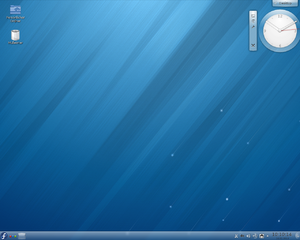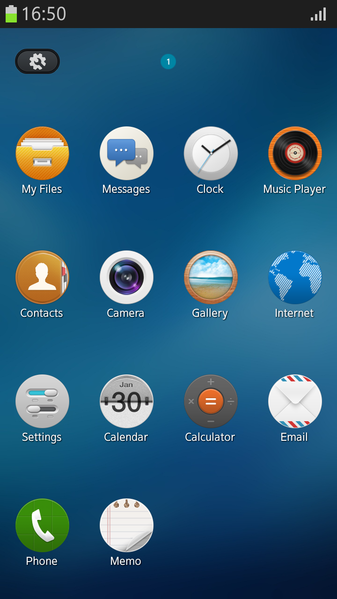11.23.13
Posted in GNU/Linux, Mandriva at 5:43 pm by Dr. Roy Schestowitz

Summary: The “OpenMandriva” branch of Mandrake/Mandriva shows continuity in what used to be the leading GNU/Linux distribution for desktops/laptops
REMNANTS of Mandrake include PCLinuxOS, which is a wonderful distribution [1], but from Mandriva too comes a new release, known as OpenMandriva Lx 2013.0 [2,3]. The staff which left Mandriva is saying goodbye to Mageia 2 [4] and those who support Mandriva-based distros continue to shuffle [5], showing us that Mandriva is able to thrive in branches and forks. Having more choices is essential for a project’s survival and expansion. Mandrake/Mandriva was once the most widely used desktop distribution. It can still make a huge comeback. █
Related/contextual items from the news:
-
If you prefer the do-it-your way experience, opt for the KDE MiniMe version. You will get a basic KDE desktop to configure your way. This version is intended for advanced users who know how to fine-tune their system. It is a much smaller ISO file that lacks printer drivers. You add what drivers you need as well as whatever other elements you want beyond the bare-bones KDE installation. – See more at: http://www.linuxinsider.com/story/PCLinuxOS-Makes-Desktop-Linux-Look-Good-79418.html#sthash.VNYARlCM.dpuf
-
-
The OpenMandriva Lx teams are pleased to announce the availability of the 2013.0 final release!
-
-
2. PCLinuxOS has been updated and it now fixed the SCIM IME. That is simply great! PCLinuxOS 32 bits is my gaming OS as it gets to play my DESURA and STEAM games perfectly.
3. Mageia 3 remains the same with some updates. This is my academic distro and my family OS (it was user accounts for my family)
Permalink
 Send this to a friend
Send this to a friend
Posted in Apple, GNU/Linux at 5:25 pm by Dr. Roy Schestowitz

Summary: By trying to copy OSuX we are led to the trap of helping to reinforce the notion that OSuX is better and hence we can only ever play catchup
Variants of Ubuntu are becoming a force to be reckoned with, especially amid controversies involving privacy, trademarks, and more. Pear OS 8 is an interesting variant which targets new form factors [1] but doesn’t always shine [2]. It recently had a new release. Pear OS 8 is somewhat controversial in the GNU/Linux world not because it imitates Apple poorly but because it strives to imitate Apple, which basically downplays our strengths and reinforces that notion that Apple’s OSuX is somehow better. Distributions which tried to mimic Windows — even Vista — got chastised for similar reasons. █
Related/contextual items from the news:
-
Pear OS is a Linux-based operating system designed to combine the beauty of Apple software with the utility (and open nature) of GNU/Linux. A year ago that meant making Ubuntu look like OS X. Now it apparently means giving Ubuntu an OS X and iOS 7-style user interface.
-
I love distros that try and mimic other OSes. They lessen the blow of using a new OS and encourage inexperienced users to take the plunge into Linux. In that respect, Pear OS 8 is a wonderful imitation of Mac OS X, but does a poor job of presenting the best of Linux.
Permalink
 Send this to a friend
Send this to a friend
Posted in GNU/Linux, Kernel, Microsoft, Novell at 3:12 pm by Dr. Roy Schestowitz

Summary: Why K. Y. Srinivasan has become somewhat of a Microsoft mole inside the Linux world
Microsoft loves to abduct companies, fire ‘disobedient’ staff, and bring in its own moles. VMware and Yahoo are good examples of this. The strategy is used a lot by Microsoft, quite consciously too.
“Microsoft never needs to be allowed to join, it just needs to abduct companies which are already in.”Right now we learn that a “Winamp Petition Emerges as Microsoft Considers Purchase”. Win is short for Windows, so it would not be too shocking if Microsoft took over to exploit (and ruin) the brand. But there are problems close to home, involving Linux in particular. There are more Elop-type threats — ones which turn Linux leaders (like Nokia) into Linux foes that go as far as patent litigation against Linux. Now that people from Microsoft are becoming managers in the Linux Foundation (and managers of distributions like Ubuntu) we must pay attention. Nokia is a Linux Foundation member too, so with its surrender to Microsoft (like Novell) there are more Trojan horses (steering power) for the monopolist inside the foundation. Microsoft never needs to be allowed to join, it just needs to abduct companies which are already in.
There is another longtime mole which deserves to be named now that there is this new puff piece and shameless PR for the company that attacks Linux. The puff piece comes from EFY Times and it’s basically a softball monologue for Microsoft, courtesy of K. Y. Srinivasan from Novell (his online profiles are still out of date). He now receives his salary directly from Microsoft and he is always whitewashing Microsoft and trying to match-make Linux with it (his focus is proprietary Hyper-V, which he and Novell helped Microsoft interject into Linux). Watch how Microsoft is grooming him in an attempt to make Microsoft seem Linux-friendly (article by Kerry Godes from Microsoft’s marketing team). To quote K. Y. Srinivasan: “It’s all part of our larger vision, which is to ensure that anything our customers want to run, they can run on Windows Server Hyper-V and in Windows Azure. This is what customers tell us they want.”
So in other words, it is about taxing and controlling (and spying on) GNU/Linux by making Microsoft its seller. It is also about running GNU/Linux merely as a guest on Windows hosts, using proprietary software of course. So much for friendship with Linux… █
Permalink
 Send this to a friend
Send this to a friend
Posted in GNU/Linux, Ubuntu at 2:25 pm by Dr. Roy Schestowitz

Photo from linuxmint.com
Summary: A so-called accusation (made in a personal blog) causes a media storm which neither Clement Lefebvre nor Canonical seem to be happy about
ONE of the best GNU/Linux distros (distributions of GNU, Linux, and desktop environments, complete with general-purpose applications), based on relative measures of popularity at least, is Linux Mint. It is so popular that in DistroWatch it beats Ubuntu sometimes. Canonical, which is in the centre of several controversies (over trademarks, privacy, and request for ‘licensing’ of binary packages) must realise that alternatives like Linux Mint can outgrow Ubuntu. There is a screenshots tour of Linux Mint 16 [1] and the release is imminent (now in RC [2-5]).
“Neither side was particularly upset over the original remarks, so to frame it otherwise would be somewhat dishonest.”Some people want us to believe that Canonical uses FUD to discourage exploration of Mint as an alternative to Ubuntu (which Mint is a derivative of). Those people, however, base their analysis on the words of just one developer [6] whose words are rebutted by the Mint founder [7] (he is also unhappy about the source of the drama, namely Muktware [8,9], which led to more such coverage [10,11,12]). In trying to judge this, the whole scenario was a demonstration of media gone somewhat rogue, hostile where opportunism lies.
We have been watching this controversy closely for a number of days and it seems like sensationalist authors did a disservice and created an unnecessary rift. Neither side was particularly upset over the original remarks, so to frame it otherwise would be somewhat dishonest. It is very different from what happened recently when it comes to trademarks. Canonical and Shuttleworth (personally) were at fault and the EFF points this out in some follow-ups [13,14,15]. It is important to keep a sober balance and only criticise Canonical (Ubuntu steward) where the company (as a matter of company-wise policy) does something unethical. Presumption of guilt only leads to noise and distraction from the real issues. █
Related/contextual items from the news:
-
Linux Mint 16, code-named Petra, will be the next stable edition of Linux Mint, a desktop distribution based on Ubuntu Desktop. It could be released sometime this month or early next month (December).
This distribution’s release track record suggests that Linux Mint 16 will be released less than two weeks from today. And when that happens, it will be the first stable edition of Linux Mint with Cinnamon 2.0 desktop pre-installed.
-
Today in Open Source: Download the release candidate of Linux Mint 16. Plus: Will preloads help Linux? And the top five Linux games
-
-
The release candidate version is now out for Linux Mint 16 ‘Petra’ with MATE and Cinnamon 2.0 desktop flavors.
It’s getting close to another six-month update for the Ubuntu-based Linux Mint and the big feature this time around is the Cinnamon 2.0 desktop.
-
Clement Lefebvre had the pleasure of announcing a few hours ago, November 15, 2013, that the Release Candidate version of both the Cinnamon and MATE editions of the upcoming Linux Mint 16 operating systems are now available for download, and testing, from mirrors worldwide.
-
Among these outlets were the OMGUbuntu and Muktware sites, both of which only deal with Linux and FOSS stories. In that context, it was even more surprising that they carried such reports.
Muktware editor Swapnil Bhartiya was asked whether reporter Monika Bhati, the person who filed the story quoting Grawert and contributing to the hysteria, was a Linux user and also whether she had taken a look at the Mint update utility before writing.
His response: “She is a resident journalist and uses Windows/Linux. We got Robin Jacobs to dive into the git pages and comments in LM to see how updates are labelled.”
Jacobs also wrote a story which, in effect, contradicted Bhati’s story – and both stories appeared within 4½ hours of each other on November 18.
The editor of OMGUbuntu, which contributed to the same idea being spread, was asked similar questions to those put to Muktware.
-
-
-
Ubuntu developer Oliver Grawert does not prefer to do online banking with Linux Mint. The reason being its unsecure handling of packaging upgrades that could leave the system vulnerable to attacks.
-
-
There have been disturbing reports in the media about Linux Mint having security problems. Is this something to worry about or has it been wildly overblown by the press?
-
-
Though Lee was not required, by the law, to remove the logo he removed it.
-
Over the past few days, EFF and one of our staff technologists, the talented Micah Lee, have had an illuminating back and forth with Canonical Ltd over the use of the Ubuntu mark. While we don’t believe that Canonical has acted with malice or intent to censor, its silly invocation of trademark law is disturbing. After all, not everyone has easy recourse to lawyers and the ability to push back.
That matters, because Canonical’s actions reflect a much bigger problem: a pervasive and unfounded belief that if you don’t police every unauthorized use of a trademark you are in danger of losing it. We hope that some clarity on this point might help companies step back from wasteful and censorious trademark enforcement.
First, some background. This particular story begins in 2012, when Canonical made the disappointing and widely criticized decision to integrate Amazon results into searches conducted through Ubuntu’s desktop dash (this meant that a user searching for one of her own files would receive results from Amazon). At the time, we argued that this default setting raised significant privacy concerns. A few weeks ago, Micah published a web site—at https://fixubuntu.com—that provided users with code to disable this privacy-invasive “feature.”
-
The Electronic Frontier Foundation, an organization devoted to the protection of freedom in the open source world, has criticized Canonical and Mark Shuttleworth.
Permalink
 Send this to a friend
Send this to a friend
11.22.13
Posted in Free/Libre Software, GNU/Linux, Microsoft at 6:41 am by Dr. Roy Schestowitz
More beneath the surface…

Summary: It may take many Elops before society as a whole can recognise Microsoft’s danger/threat to jobs, productivity, innovation, and plurality in the technology sector
WHEN Microsoft moles start to take over something they typically get the job done. In the case of Nokia, Yahoo and Novell, where the companies are fairly large, the hijack (completion of the job) can take several years to complete. The vulture just keeps circling the prey, weakening it by driving away resistance. Microsoft has been trying to infiltrate and in some hopeful sense take over FOSS, sometimes with the help of proxies set up by former Microsoft marketing managers for whom Indian ‘news’ (PR) sites are kindly reposting press releases with very slight edits. This helps the takeover. To a certain degree, Microsoft has been successful, even while simultaneously suing FOSS using patents. Another company which has been taking over by many former executives from Microsoft is VMware, whose former manager, who had come from Microsoft, became a manager at the Linux Foundation just earlier this month.
Don’t lose sight of Microsoft. The vulture is void of ethics and it’s always looking for the next kill. Nokia was a top Linux contributor before Microsoft killed it (just days ago the takeover became official). █
Permalink
 Send this to a friend
Send this to a friend
11.18.13
Posted in GNU/Linux, Red Hat at 9:59 am by Dr. Roy Schestowitz
The KDE version back in Fedora 18 days (a year ago)

Summary: Fedora 20 is almost ready and Techrights members who use Fedora say that it is good and rather polished
RED HAT has become very serious about OpenStack and all that Fog Computing hype, arguing that it’ll mature just like Linux [1]. Red Hat is still a servers company, not a desktop company, even though the company is fostering the desktop side through projects like Fedora.
Fedora is a very important project and it is said to be improving polish-wise [2] and performance-wise [3]. The next release (20) is now in beta [4,5,6] and there are already screenshots of its KDE ‘flavour’ [7], which I last used in 2011. Some people on the Web have told us (e.g. in IRC) that Fedora is no longer plagued by bugs and usability wrinkles, so maybe it’s time to give Fedora a try. The final release is imminent. █
Related/contextual items from the news:
-
Charlie Peters, CFO of Red Hat, says to expect a big bounce in service revenues in 2014 on the strength of the company’s OpenStack push.
-
Heisenbug is just a name: Red Hat’s Robyn Bergeron tells Sean Michael Kerner about the new Fedora’s SDN and storage improvements
-
Due to Fedora 20 development releases shipping with debug symbols and other non-release-ready code, the tests today were limited to just giving a quick overview of the performance differences between Fedora 20 Beta and Fedora 19. Fedora 19 was tested in both its stock configuration and then installing all available updates. For ruling out some of the performance issues on Fedora 20 Beta due to the debug state, “slub_debug=-” was set as one of the kernel command-line parameters.
-
-
-
First things first, what the heck is a Heisenbug? It’s not a made-up word. It’s programmers’ jargon, spun off from Heisenberg’s Uncertainty Principle, for “A bug that disappears or alters its behavior when one attempts to probe or isolate it.” For Linux users it’s also Red Hat’s next community Linux, Fedora 20.
-
Permalink
 Send this to a friend
Send this to a friend
Posted in GNU/Linux, Google at 8:53 am by Dr. Roy Schestowitz
Tizen still a contender

Summary: Mobile contenders such as Ubuntu, Firefox, and Tizen are still in the game, chasing Android and sometimes scoring hardware (preinstallation) deals
THE GROWTH of Android is almost inarguably fantastic (from zero percent to 80% in just a few years), but Android is not the only game in town as far as ‘small’ distributions of */Linux are concerned. Sailfish OS, which comes from Nokia (former staff), is looking increasingly mature [1] and smartphones running this operating system are expected to come out this month [2]. Pessimists don’t think that non-Android Linux tablets can do well [3], but when it comes to smartphones there are several challengers and they include Ubuntu, Firefox, and Tizen.
Samsung, a leading user of Android, actually uses Tizen for cameras [4-6] — not smartphones [7] — leaving the ‘alternative’ smartphones field (Linux-based but not Android) open for MeeGo refugee from Nokia/Jolla. It is worth noting that many of these systems are inter-connected in the code sense, and not just owing to Linux. Since they are abundantly free/libre, there is room for sharing. Modularity in smartphones [8] goes a long way in ensuring innovation. In a sense, this involves as much collaboration as competition. Apple can’t compete with that. █
Related/contextual items from the news:
-
…we have found out about the mapping system on Sailfish OS made by the Swedish company called Appello based on HERE maps material.
-
Finnish startup Jolla has revealed when the first batch of its Sailfish OS–based smartphones will be available to customers, along with new information about what software will be on offer when the devices ship.
On Thursday, the company announced via Twitter that the handsets will go on sale in Finland first, thanks to Jolla’s partnership with local carrier DNA. The devices will hit retail shelves in Helsinki on November 27, with a price tag of €399.
-
Canonical with their Ubuntu Touch initiative isn’t the only project that’s failed to deliver as of yet with a successful non-Android Linux tablet.
While there’s arguably still hope left for Ubuntu Touch to become a commercial success, there’s been more Linux tablet projects that have faded away.
-
-
There was Tizen news aplenty at the Tizen Developer Summit including a Tizen 2.2.1 release, new details on Tizen 3.0, a Tizen-based Samsung NX300M camera, and an upcoming Tizen Mobile Lite version for low-end phones. Yet, there was no sign of the Tizen phone, and a Samsung executive was quoted as saying that the first Tizen phone would be delayed until 2014.
-
While lawyers pettifog their patent arguments in the Apple-Samsung World Series, the South Korean has been quietly recruiting partners and developers to Tizen, and has launched its first Tizen-based product – a camera, not a phone.
While the South Korean company is acting as evangelist-in-chief for the Tizen operating system, the project itself has a couple of years of history behind it, having been established in 2011 by the Linux Foundation.
It’s been a bit of a slog: back in May, the project still expected its first smartphones to land by the end of this year, something that’s proved unachievable.
-
Tizen is a fresh new project, but it has roots in several pre-existing platforms including the distributions Moblin, MeeGo and LiMo. According to the Tizen Association, “The mobile marketplace has undergone extensive change over the past few years. New platforms have emerged, new revenue models have been enabled, and innovations continue to emerge rapidly from all corners of the industry. Tizen is an open-source solution that provides an innovative platform offering a high level of flexibility in service selection and deployment.”
-
Modularity in smartphones could “go a long way to overcoming whatever inflexibility is left in the system of small, cheap computers,” blogger Robert Pogson suggested. “Rather than just tweaking software, the end user or retailer can mix and match bits of the hardware, too.
Permalink
 Send this to a friend
Send this to a friend
Posted in GNU/Linux, Google at 8:25 am by Dr. Roy Schestowitz
The operating system part of the stack is growingly free, like an open book

Summary: How Linux (often with GNU as a core system) is taking root in everything, from micro to macro
LITTLE by little, Linux spreads all over Earth and beyond. It is constantly growing on the desktop (even in space [1]) and on the ‘cloud’ (server). Mr. Pogson takes note of the growth of GNU/Linux at Microsoft’s expense [3,4], demonstrating with numbers that “Linux Did Well In 2013″ (as in previous years). Android plays a significant role here.
Consider some of the latest claims from Linux foes Gartner and IDC. Gartner cannot deny Android’s growth [5] and neither can IDC, which reported on it through IDG [6] (conflict of interest) and other venues [7,8]. It is good not just for Google because Android can be forked and it is already being forked by at least three notable efforts (2 of which are freedom-oriented). CyanogenMod is the most notable alternative/branch/fork, which even Google Play Store is willing to foster [9,10] as a new version, Android 4.4 KitKat, comes out [11-14].
Apple’s co-founder (the one who is still alive) suggests that Apple should turn to Android [15], which is better for developers [16,17] and for users that receive more and more features, as well as cutting-edge software [18,19]. Android is rapidly going upwards (ascending from 80% market share and perhaps reaching 90%), but this doesn’t mean that there are no Linux-powered challengers (Android independent, but sharing some code like Linux), as we shall show in a moment. This will be the subject of our next post. █
Related/contextual items from the news:
-
I’m a little late in my reporting, but this year, in May, the International Space Station (ISS) dumped the last of its laptop installations of the Windows XP operating system to go all Linux.
Furthermore, it dropped Red Hat Linux in favour of Debian 6, according to the Linux Foundation, which provided two training courses geared specifically for the USA/NASA team’s needs.
-
Linux on the server has been respected and regarded in technology circles for many years now.
One of the main reasons for this is that Linux is argued to be especially competent at handling “many processes at once”, something Windows has traditionally not done quite so well.
-
Even StatCounter, which undercounts */Linux severely, shows the trends…
-
The leader of the CEO hopefuls wants to port M$’s office suite to other platforms to sell more. There goes lock-in for the client OS.
He also wants to shutdown/sell Xbox and Bing to get back to core businesses and shed employees.
Two zero-day flaws are being exploited in the wild and M$ can’t do anything about it…
M$ can’t add and doesn’t even try (more on this).
M$ is still losing share in client OS even on legacy PCs.
-
-
-
-
Google’s Android operating system reached a new milestone during the third quarter of 2013 (3Q13), according to the International Data Corporation (IDC) Worldwide Quarterly Mobile Phone Tracker. With a total base of 211.6 million smartphone units shipped during the quarter, Android accounted for 81.0% of all smartphone shipments, marking the first time that Android topped 80% in its short history. Despite high saturation rates in a number of mature markets, the overall smartphone space grew 39.9% year-over-year in the third quarter.
-
-
Cyanogen Inc., the newly created company that produces the popular custom Android ROM CyanogenMod, published a new app called CyanogenMod Installer which will unlock the user’s boot loader, root their device, and flash CyanogenMod to their phone with minimal extra effort. The free app is available over Google Play, and when it’s paired with equally free desktop software, this can replace a phone’s operating system with Cyanogen Inc.’s highly customizable version of Android.
-
Google’s latest mobile operating system, Android 4.4 KitKat, is out and it comes pre-installed on Nexus 5. Android enthusiasts and developers were very excited for this new smartphone as well as the new operating system. But now that KitKat is available for Nexus 5, we can get our hands on this new OS. If you’ve got any Nexus or Google Play edition devices, then you too may be getting Android 4.4 KitKat in the near future. Unfortunately, Galaxy Nexus users won’t get this new update.
-
After three Jelly Bean releases in a row, Google has unleashed a major revision to the world’s most widely used operating system. With the Nexus 5 comes Android 4.4 “KitKat.” KitKat brings a ton of enhancements: support for hidden system and status bars, printer support, and lower memory usage. It also has a number of user-level improvements, including a new dialer, a Google-infused home screen, and a whole pile of UI refinements.
-
-
Wozniak told the BBC that Apple would be more powerful if it had a good professional relationship with Google. Apple would be able to improve services such as voice-assistant software Siri (thanks to Google’s search-engine ties) and even develop better wearable tech, such as smartwatches and augmented-reality glasses, Wozniak said.
-
Heads up, Android devs: it’s now easier than ever to localize your app, thanks to the newly launched App Translation Service from Google.
-
-
-
-
Permalink
 Send this to a friend
Send this to a friend
« Previous Page — « Previous entries « Previous Page · Next Page » Next entries » — Next Page »

























 Content is available under CC-BY-SA
Content is available under CC-BY-SA